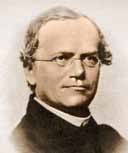Gene Peas

By Terri Sota
Gregor Mendel became a father half a century after his death. His 1865 seminal paper, Experiments in Plant Hybridization, engendered little interest. It was not until the early decades of the 1900s that the scientific community suddenly embraced Mendel as the "Father of Genetics." Long before the identification of genes, chromosomes and meiosis (a.k.a. reproductive cell division), Mendel theorized that specific characteristics were the product of "coding" from both parents and passed, sometimes unseen, to successive generations. Yet, despite his proven prescience, the true significance of his discoveries remained obscured until Darwinian theory was seen as a change in the Mendelian messaging mechanism, in populations over time.
Born in 1822 on a farm in Heinzendorf, Austria (now the Czech Republic), Mendel entered the Augustinian Abbey of St. Thomas in 1843. There he took an interest in experimental gardening, which led to a sabbatical of study at Vienna University. Gregor returned to teach physics and mathematics and, in 1956, began his work with pea plants in the Abbey's greenhouse.
Why Peas?
Mendel recognized an either-or quality to their display: the flower color was either white or purple, the flower position was either axial or terminal, etc. Because they were hermaphroditic, reproduction via self-pollination or cross-pollination could easily be manipulated. Their (relatively) rapid rate of reproduction enabled Mendel to observe up to two generations in one year.
Mendel's theories came to be known as the Law of Segregation and the Law of Independent Assortment. The former suggests that for every offspring trait, there is a pair of "alleles" responsible for the genotype (chromosomal mix) and the expression of the phenotype (observed, dominant allele). In the latter law, Mendel contends that allele pairs are passed to gametes independently of one another. Thus, the probability of the offspring being "purple" is independent of it stem length. Geneticists have since proven that incomplete dominance, codominance and linkage (i.e., same-chromosome alleles inherited together) are exceptions to this law.
Without the benefit of microscopic inquiry, Mendel relied on his meticulously recorded observations of 28,000 pea plants between 1856 and 1863. He deduced that although one generation of offspring fails to display a certain characteristic, the coding for the trait is still inherited, albeit as a recessive gene. Today, doctors can assess the probability of certain birth defects and diseases before conception, thanks to Mendel's investigations into the genetic can of peas.
Classroom Discussion
- Illustrate the difference between phenotypes and genotypes using either Punnett squares or tree diagrams
- Calculate the probability of two or three generations of offspring displaying a recessive trait (after cross-pollinating parent plants that are homozygous for two colors of flowers)
